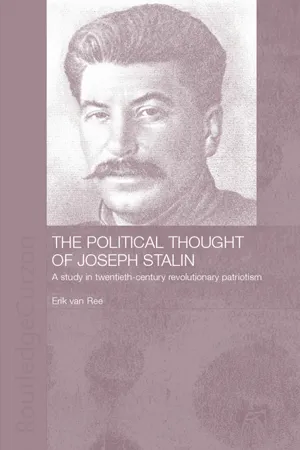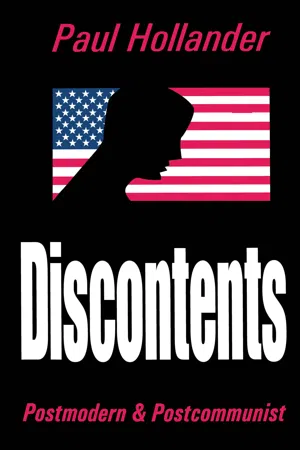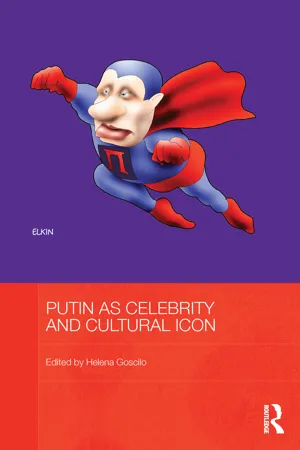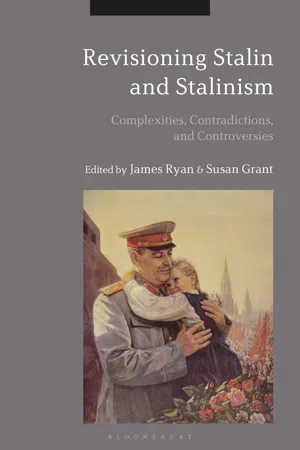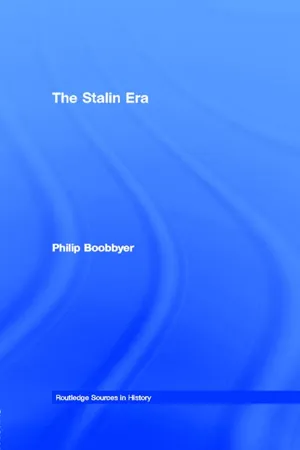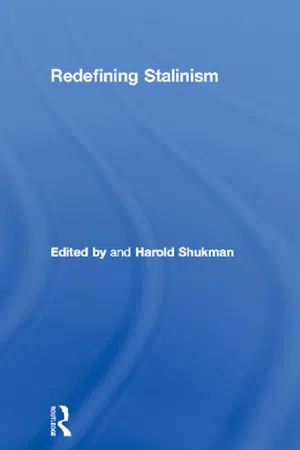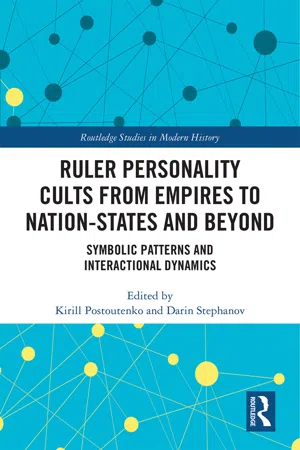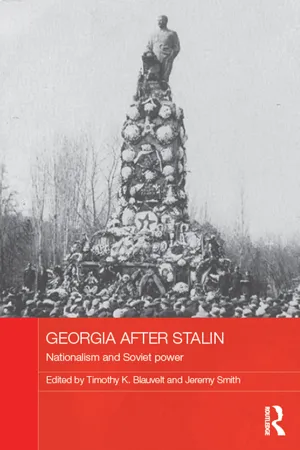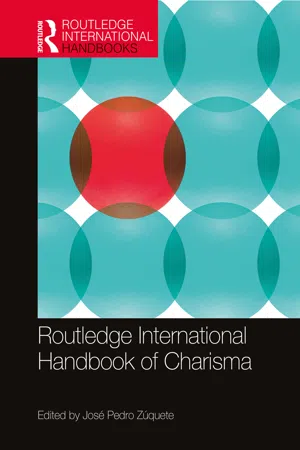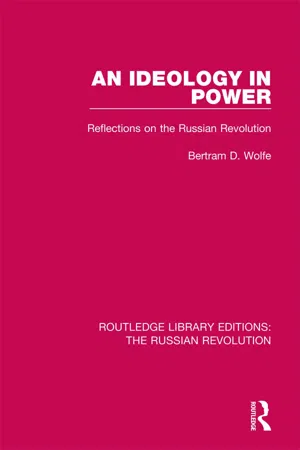History
Stalin's Cult of Personality
Stalin's Cult of Personality refers to the extensive propaganda and glorification of Joseph Stalin during his rule over the Soviet Union. This involved the promotion of his image as a heroic and infallible leader, with his personality cult permeating all aspects of Soviet society. It served to consolidate his power and control, while also fostering a climate of fear and obedience among the population.
Written by Perlego with AI-assistance
12 Key excerpts on "Stalin's Cult of Personality"
- eBook - ePub
The Political Thought of Joseph Stalin
A Study in Twentieth Century Revolutionary Patriotism
- Erik van Ree(Author)
- 2003(Publication Date)
- Routledge(Publisher)
12 The cult of personalityOne of the main characteristics that Stalinism became notorious for was the cult of the leader’s personality. Stalin was presented in books, journals and newspapers, in prose and poetry, in song, painting and sculpture, as a flawless genius and hero, on a par with similar extraordinary historical personalities like Karl Marx and Vladimir Il’ich. The cult reflected the dictatorial power that its object established in real life. Stalin established this personal dictatorship by crusading against all informal centres of power with a degree of autonomy, in the party, in the regions and in state institutions. He waged this crusade under the banner of struggle against the old “family traditions,” which he denounced even before the revolution. The struggle against entrenched “families” (autonomous groups based on personal relations, friendship and mutual protection) reflected his harsh views of how a party should function as well as his strategy for personal rule.At the party congress in 1927, the leader complained that problems were often solved “in a family way, as if at home.” When Ivan Ivanovich makes a mistake, his friend Ivan Fedorovich “does not want to criticise him, bring to light his mistakes, correct his mistakes.” The latter Ivan hoped that his leniency would be rewarded in the future when he was in trouble. Was it not ironic, Stalin asked, that the bolsheviks, who were out, in Marx’s words, to storm the heavens, were not prepared to storm each other? They should understand that bad things do not disappear from themselves. “That which dies, does not simply want to die, but it struggles for its existence, defends its lost [otzhivshee] cause.” And conversely, that which is newly born must shriek and cry out to defend its right to exist. Correspondingly, true leadership was to combat, to spare no one irrespective of friendship, and to reject the tendency to “swim with the current.”1 - eBook - ePub
Hitler, Stalin, and Mussolini
Totalitarianism in the Twentieth Century
- Bruce F. Pauley(Author)
- 2014(Publication Date)
- Wiley-Blackwell(Publisher)
Plate 7 ). His own status as a cult figure dates at least in part from the celebration of his (alleged) fiftieth birthday in 1929 when the Soviet press printed hundreds of letters written “spontaneously” in praise of him by people from all walks of life.Like God, Stalin was not only all-knowing, but also all-good, all-just, and all-powerful. The national anthem mentioned him by name – something that even Hitler and Mussolini dared not demand. Stalin himself raised his cult to a new height by publishing a book entitled History of the All-Union Communist Party: Short Course in 1938. Better known simply by its subtitle, it became the bible of High Stalinism. It was absolutely breathtaking in its distortion of history: all of his opponents were shown as agents of imperialism, while Stalin was credited with organizing the revolution, establishing a productive and prosperous agriculture, smashing treason, and leading the world’s proletariat. To make sure that the masses got the point, he also carefully monitored fictionalized films. Paintings depicted Stalin leading strikes before the revolution and advising a complaisant Lenin. Almost every office and private home was adorned with an idealized portrait of the great leader.The degree to which the general public accepted the Stalin cult is difficult to determine, as indeed are all aspects of public opinion in a totalitarian dictatorship. There is some evidence that the exalted image of Stalin was widely accepted by millions of Soviet people from all backgrounds and occupations, whose livelihoods were governed by the enormous state apparatus and who owed their jobs directly to the dictator. In any event, Stalin’s deification made it impossible for the Communist party to control him and it justified in advance everything he did. - eBook - ePub
Discontents
Postmodern and Postcommunist
- Paul Hollander(Author)
- 2018(Publication Date)
- Routledge(Publisher)
23The Cult of Personality in Communist States 1Virtually every communist system, extinct or surviving, at one point or another, had a supreme leader who was both extraordinarily powerful and surrounded by a bizarre cult, indeed worship. In the past (or in more traditional contemporary societies) such cults were reserved for deities and associated with conventional religious behavior and institutions. These cults although apparently an intrinsic part of communist dictatorships (at any rate at a stage in their evolution) are largely forgotten today.The term was born of an attempt of Nikita Khrushchev to explain away (in a highly un-Marxist manner) the deformation and defects of the Soviet system under Stalin. Khrushchev introduced it at the 20th Party Congress in 1956 to describe and define Stalin’s misrule and notorious abuse of power. The officially enforced cult of him was one aspect of his misrule. As Khrushchev saw it, or wished his audience to see it, Stalin’s personality—including his desire to be an object of a cult—was responsible for everything that went wrong with the Soviet system.Stalin, Mao, Castro, Ho Chi Minh, Kim II Sung, Enver Hoxha, Rakosi, Ceascescu, Dimitrov, Ulbricht, Gottwald, Tito and others— all were the object of such cults. The prototypical cult was that of Stalin which was duplicated elsewhere with minor variations. Arguably some other cults and the intensity of the worship they entailed— notably those of Mao, Kim II Sung and Hoxha—exceeded Stalin’s.It is a surprising aspect of the study of communist systems—and especially its comparative variety—that this cult has been of little scholarly interest and hardly ever identified as one of their shared, institutionalised characterisic. Why has it received so little attention is in itself an interesting question. Perhaps because of an all too ready acceptance of the claims of these systems as highly rational undertakings (which would be incompatible with such a cult), or with the difficulty of reconciling their official Marxist ideology with a phenomenon such as the cult; possibly this lack of attention may also be connected with Western attitudes which sought to differentiate communist from other totalitarian systems which too had such cults. - eBook - ePub
- Helena Goscilo, Helena Goscilo(Authors)
- 2012(Publication Date)
- Routledge(Publisher)
permanent attachment” (Oushakine 2000a: 1009, 1010). This provocative claim suggests that Soviet discourse, in essence, has become a post-Soviet fetish and that Russia’s civil society currently finds itself in a state of arrested development. Our examination of Putin mania leads us to a less gloomy conclusion. If we accept Oushakine’s premise that nations pass through life stages roughly equivalent to those experienced by individuals, we can understand both the Putin cult and the earlier personality cults it recalls in terms borrowed from Jacques Lacan’s theory of psychosexual development.As the most vivid example of a cult of personality, the Stalin cult indeed arrested the Soviet Union’s cultural development in what Lacan would call the mirror stage (Lacan 2006: 75–81). Much like the individual infant, whose ego is first constituted “through jubilant identification with its reflection, experienced as a powerful gestalt promising mastery, unity, and substantive stature,” Soviet society located its all-powerful, collective ego in the image of Stalin, the “father of all peoples,” “great architect of communism,” and “gardener of human happiness” (Muller and Richardson 1982: 6). In effect captivated in a dyadic relationship with the omnipotent image of Stalin, Soviet society failed to develop a symbolic register that would permit critique of the cult itself and, more importantly, the formation and expression of individual desire. In other words, Soviet cults of personality locked the country in an imaginary realm dominated by the leader’s image, which not only constituted national identity through a collective act of méconnaisance - eBook - ePub
Revisioning Stalin and Stalinism
Complexities, Contradictions, and Controversies
- James Ryan, Susan Grant, James Ryan, Susan Grant(Authors)
- 2020(Publication Date)
- Bloomsbury Academic(Publisher)
5The Stalin cult in comparative context
Judith DevlinThe Stalin cult was once explained by reference to the leader’s pathological personality power and understood to be a key feature of totalitarianism. It has also been adduced as an instance of Russian exceptionalism.1 However, a burgeoning literature on leader cults suggests otherwise.2 Although there were precedents in the nineteenth century, the real heyday of leader cults came in the aftermath of the First World War when a crisis of authority was precipitated by the shattering of the old political order. Neither victory nor defeat seems to have determined their development. Countries that could claim to be beneficiaries of victory (such as Czechoslovakia and Poland) as well as those that emerged from defeat (like Turkey and the Weimar Republic), and those whose victory or defeat in the war was reinterpreted (Italy and the Soviet Union), all witnessed leader cults. They developed not only in so-called totalitarian regimes, dictatorships and authoritarian orders, but also in (albeit fragile) democracies.Despite the differences between them, these regimes had one thing in common: they operated in unstable and fissiparous or destabilized states that had emerged from the ruins of the old monarchical order of Central and Eastern Europe. As republics, our case studies claimed legitimacy from popular sovereignty but, despite adopting or invoking, at least initially, some of the practices and institutions of democracy, giving functional expression to the popular will remained problematic in the face of internal conflict and poverty. These new dispensations developed a personalized symbolic politics out of a common need to forge from a diverse, disputatious or indifferent population a united and committed nation on which to stabilize the state.3 This study will focus not so much on the totalitarian leader cults that are the usual point of comparison for the Stalin cult but on those surrounding Piłsudski , Atatürk, Hindenburg and Masaryk.4 - eBook - ePub
The Neo-Stalinist State
Class Ethnicity & Consensus in Soviet Society
- Victor Zaslavsky(Author)
- 2016(Publication Date)
- Routledge(Publisher)
It is widely accepted that the rebirth of the Stalin cult is due to the emotional attachment of the present leaders. In fact, many of today's leaders started their political careers during Stalin's time. He made Brezhnev a member of the Central Committee; it was in Kosygin's company that he was last seen in public; Gromyko, subsequently the minister of foreign affairs, was then a vice-minister; Epishev, subsequently the chief of the Central Political Directorate of the Armed Forces, was then in charge of the vice-ministry of state security; Ustinov, now defense minister, was then minister of armaments. The list could go on. It is well known, however, that gratitude to dead leaders is a rare quality among politicians and hardly influences the course of events. Many members of the group in power are indebted even more to Khrushchev, but this has not stopped them from prohibiting the mention of his name in the press even today. The current leaders' sympathy and approval of many of Stalin's policies have favored, but not determined, the rebirth of the ex-dictator's cult.What has happened becomes much more intelligible when seen within the context of the organization and the structure of power in the Soviet Union. Soviet society has been correctly described as a mono-organizational system.10 This fact is codified in the Constitution, which designates the CPSU as "the force directing and guiding society." This means that the party's bureaucratic apparatus, which has become one with state power, dominates society by organizing and directing the activity of otherwise totally atomized individuals. The party apparatus is in no way equal to the sum of individuals carrying out various tasks at any given moment. The apparatus consists of the totality of social roles, norms, relations, and laws, including the laws of self-reproduction and self-preservation. In turn, the functioning principle of this system — democratic centralism — inevitably leads to domination by the highest, "personified" echelon over the entire party apparatus.11The birth of the personality cult — through the concentration of power in the hands of a restricted number of people who choose the Leader and ascribe to him an artificial charisma — is the natural result of the operation of the single-party system. The Leader's personal qualities and good intentions do not change the situation. Despite Lenin's personal opposition, his cult was born and gained strength during the last years of his life, reaching its peak in the unprecedented decision to erect a mausoleum to preserve his embalmed remains. The history of the Stalin, Khrushchev, and Brezhnev cults shows how these mechanisms of cult manufacture work and are likely to develop. The apparatus's absolute power finds its most adequate embodiment in the Leader's personal power acting in the name of the apparatus and executing its will. - eBook - ePub
- Philip Boobbyer(Author)
- 2012(Publication Date)
- Routledge(Publisher)
It has been observed that Stalin was not just a ‘master planner’, but also a fallible human being who sometimes reacted to events. Svetlana Alliluyeva's perspective supports this. To take such an approach does not mean to minimise Stalin's evil behaviour; it is simply to observe that there was something very ordinary as well as monstrous about it. As Getty writes, comparing Stalin to Eichmann: ‘His evil, like Eichmann's, was ordinary and of this world; it was banally human and is more horrifying for being so’ (1993: 62). The suggestion that Stalin was in the grip of certain inner compulsions suggests a weak man, and that his hardness compensated in some way for some unrecognised inner problems. Certainly a pyschological approach to the study of Stalin can only lead to the conclusion that key aspects of the political system were products of his own psychological needs (Tucker 1992: 171). The Stalin cult is an example of that. The cult, even if it developed a life of its own and had wider social causes, had roots in Stalin's character. The origins of the personality cult can in part be found in the Lenin cult, of which Stalin had made himself chief guardian, and which set a precedent for things to come. The Stalin cult itself began to gather momentum at the time of Stalin's 50th birthday in December 1929, when workers throughout the USSR issued resolutions extending their birthday greetings to Stalin, and he was proclaimed supreme leader (vozhd’). Pravda, over five days, listed hundreds of organisations which had sent him messages, and continued to print messages of congratulation for the next twelve months. In the first edition of Pravda in 1934, Karl Radek, the Bolshevik journalist who had supported Trotsky and been in active opposition to Stalin for many years, wrote a eulogistic article on Stalin as the ‘architect of socialist society’, which was reissued as a pamphlet - eBook - ePub
- Harold Shukman(Author)
- 2004(Publication Date)
- Routledge(Publisher)
6Therefore, although many elements of the cult were irreparably damaged by developments between 1953 and the end of 1955, the full de-mythologisation of Stalin would require more than ignoring or sideswiping the late leader, and a more consistent approach to the totalitarian culture of the cult.7 Although the death of Stalin, and this early, limited confrontation of the Stalinist past had already rendered a return to Stalinism unlikely, it was still possible, before the 20th Congress, to look to Stalin and the Stalin era at least nostalgically, and often worshipfully. Indeed, such an attitude was seemingly encouraged by the continued saturation of public space with Stalin imagery (portraits, monuments), and the enduring dominance of ‘Stalin’ as totemic figure in the history books, and therefore within the historical narratives used in the education system—notably the Kratkii kurs (Short Course)— museums and public rituals.8 - eBook - ePub
Ruler Personality Cults from Empires to Nation-States and Beyond
Symbolic Patterns and Interactional Dynamics
- Kirill Postoutenko, Darin Stephanov, Kirill Postoutenko, Darin Stephanov(Authors)
- 2020(Publication Date)
- Routledge(Publisher)
Personality Cults in Stalinism—Personenkulte im Stalinismus , edited by Klaus Heller and Jan Plamper, 331–361. Göttingen: V & R unipress.Paulmann, Johannes. 2000. Pomp und Politik: Monarchenbegegnungen in Europa zwischen Ancien Régime und Erstem Weltkrieg . Paderborn: Ferdinand Schöningh.Perrie, Maureen. 1998. “Nationalism and History: The Cult of the Ivan the Terrible in Stalin’s Russia.” In Russian Nationalism: Past and Present , edited by Geoffrey A. Hosking and Robert Service, 107–127. London: Palgrave Macmillan.Plamper, Jan. 2004a. “Georgian Koba or Soviet ‘Father of Peoples’? The Stalin Cult and Ethnicity.” In Leader Cult , edited by Apor et al., 123–140. Basingstoke: Palgrave Macmillan.Plamper, Jan. 2004b. “Introduction: Modern Personality Cults.” In Personality Cults in Stalinism—Personenkulte im Stalinismus , edited by Klaus Heller and Jan Plamper, 22–33. Göttingen: V & R unipress.Plamper, Jan. 2012. The Stalin Cult: A Study in the Alchemy of Power . New Haven, CT: Yale University Press.Plekhanov, George [G. V. Plekhanov]. [1898] 1940. “On the Role of the Individual in History.” In Essays in Historical Materialism: The Materialist Conception of History; The Role of the Individual in History . New York: International Publishers.Plunkett, John. 2003. Queen Victoria: First Media Monarch . Oxford: Oxford University Press.Polese, Abel, and Slavomir Horák. 2015. “A Tale of Two Presidents: Personality Cult and Symbolic Nation-Building in Turkmenistan.” Nationalities Papers 43, no. 3 (March): 457–478.Postoutenko, Kirill, ed. 2010. Totalitarian Communication: Hierarchies, Codes and Messages . Bielefeld: Transcript.Postoutenko, Kirill. 2019. “Stalin’s Two Bodies? A Socio-Political Dimension.” In Words, Bodies, Memory: A Festschrift in Honor of Irina Sandomirskaja , edited by Lars Kleberg, Tora Lane, and Marcia Sá Cavalcante Schuback, 379–398. Huddinge: Södertörns Högskola.Prosperi, Adriano. 2018. Justice Blindfolded: The Historical Course of an Image - eBook - ePub
Georgia after Stalin
Nationalism and Soviet power
- Timothy K. Blauvelt, Jeremy Smith, Timothy K. Blauvelt, Jeremy Smith(Authors)
- 2015(Publication Date)
- Routledge(Publisher)
During Stalin’s rule, Soviet Georgia had been effectively mobilized to defend the Soviet state and to participate in the reconstruction of Soviet society. This had, as a result, united Georgians within the Soviet Union. The de-Stalinization process that Khrushchev initiated brought up the emotions which had been built up on these national sentiments. The senses of gratitude and obligation included in the constructing process of Stalinist society were motivating factors when the students wanted to commemorate Stalin on the third anniversary of his death. National pride for Stalin, which was linked to the view on his role in the victory of the October Revolution and the World War II, was offended in the speech that Khrushchev made at the Twentieth Party Congress. The attempts to detach Stalin’s name from the Marxist-Leninist ideology and the victories of the Soviet nation confused and shocked especially young Georgians to the very fundaments of their belief system.The central problem in the ideological discussion was how to define Stalin’s role in the new ideological landscape. Khrushchev’s portrayal of the cult of personality as alien to Marxism-Leninism created problems in Georgia, where the achievements of the past were credited to Stalin, who was seen as an organic part of the Communist ideology. Despite these problems, the Georgian Communist Party had to implement the resolutions of the Twentieth Party Congress and begin campaigning against the cult of personality by reading Khrushchev’s speech to local Party and Komsomol members. In these discussions the Komosmol isolated Stalin’s role in the cult of personality by pointing out that it was an outcome of Beria’s and not of Stalin’s rule.The Georgian Party and Komsomol organizations ably made use of concepts created in Moscow for other political campaigns. The concepts of formalism, parasitism and the cult of personality were given local meanings and were used in reports that were sent back to Moscow to explain the March events. The use of the concept of formalism gave the impression that the problems in the republic were linked to the past and were already solved, whereas in the case of parasitism the problem was in the level of education and employment, which required more resources from the center.Notes1 For more detailed account of the March events see Vladimir Kozlov, Mass Uprisings in the USSR: Protest and Rebellion in the Post-Stalin Years (Armonk, NY: M.E. Sharpe, 2002), pp. 112–35; and Timothy K. Blauvelt, “Status Shift and Ethnic Mobilisation in the March Events in Georgia,” Europe-Asia Studies - eBook - ePub
- José Pedro Zúquete, José Pedro Zúquete(Authors)
- 2020(Publication Date)
- Routledge(Publisher)
Within totalitarian movements, charismatic leadership is typically institutionalized through the personality cult (Flew and Yin, 2017: 8; Horn, 2011: 100). The figure of Joseph Stalin was a model and inspiration to Mao (Walder, 2015), linking the CCP-led revolution to others movements associated with Nazism, fascism, and communism. Like Stalin, Mao and others within the CCP movement sought to construct an ideology-based political religion which required the destruction of competing truths in order to place Mao’s leadership and exaggerated role at the center of both political and nonpolitical life, distinctions between which became blurred as the CCP gained power. This domination of social life through values, myths, rituals, and symbols intended to create an aura of sanctity around Mao. Thus, this cult of personality links back to systems of political myths which sought to motivate the masses through irrational and quasi-mystical thought, and which achieved great presence and intensity in other totalitarian countries prior to the 1940s (see Gentile, 2000). While the rituals of Maoism such as veneration of Mao’s portrait and writings, worship rituals, loyalty dances, and other demonstration of obedience appeared unique, they were linked to broader patterns of transnational political authority and, in particular, totalitarian systems of authority and legitimation which existed in other times and places.The cult of personality and manufacture of charisma through media as well as more immanent forms of leader-led relationships was, in the writings of anti-totalitarian theorists such as Hannah Arendt, a critical means by which totalitarian mass leaders, movements, and organizations engaged with people who had otherwise lost, often through war or economic depression, social identity and emotional bearings. Arendt’s analysis, in particular, is instructive for understanding how charismatic leadership functions within the broader totalitarian political system. Militancy resides at the core of all totalitarian movements (Baehr, 2017: 225–230). Though Weberian charismatic leadership may partly explain their power, authority created by charisma cannot ultimately be explained without equal reference to violence, as in the cases of Stalin and Adolf Hitler. Individuals must remain permanently dislocated through the perpetual motion of the movement. Purges, secret police, and new political formations distinct from existing organizational hierarchies (e.g., during the GPCR, Mao’s “Central Cultural Revolution Group”) exist to keep other political actors unbalanced and fearful. Emphasis on ideological correctness and the existence of unseen enemies further enhances the sense of vulnerability for all members of society. Within the totalitarian movement of Maoism and “struggle,” charismatic leadership existed as both engine of transformation and technique – buttressed by violence and supra-organizational systems of investigation and punishment – for engendering loyalty through the systematic elimination of competing standpoints. - eBook - ePub
An Ideology in Power
Reflections on the Russian Revolution
- Bertram Wolfe(Author)
- 2017(Publication Date)
- Routledge(Publisher)
The Stalin cult, whose high priests these men were, has made the problem of the succession more difficult. By attributing to Stalin all successes and to themselves and their subordinates all failures, shortcomings, or unpleasant consequences, they enlarged his person until it filled the horizon, diminishing their own to the point of nullity.In this swollen form, the Stalin myth was dead as soon as his body was cold. For what right did such dwarfed men have to be individual or collective dictators? Moreover, in the end they were irked by his arrogation to himself of credit for all they did, thought up, ghost-wrote for him, by the precariousness of their positions dependent entirely on the caprice of one man, by the need each day to kindle greater clouds of incense to his name. Their cold funeral addresses, concerned with programs and power, testified to the fact that he had exacted so much “posthumous tribute” while alive that there was no reserve to call on after his death. These historians of the purge, who had rewritten recent history so often and continuously in order to enlarge and glorify Stalin’s works and name, began immediately a fresh rewriting of history to cut him down to size—not to actual size, but to their own size, so that there could be some sense in their claim to individual or collective succession. Henceforth, Lenin is the author of the great theories and the initiator of the great works, and Stalin is reduced to continuator, developer, and disciple. They, for their part, are co-disciples of Lenin and comrade-in-arms of Stalin and, by virtue of membership in the same leading body, coauthors of all the theories, policies, and plans hitherto called Stalinist.Many wrongly concluded that the process would not stop until Stalin’s name had been extinguished and his policies abandoned. But his orphaned disciples had no intentions of doing one or the other. They cannot extinguish his name, for what other claim do they have to rule the Soviet land except association with Stalin and discipleship to Lenin in an unbroken apostolic succession? Nor do they wish to abandon his policies, for these are in fact their policies no less than his.
Index pages curate the most relevant extracts from our library of academic textbooks. They’ve been created using an in-house natural language model (NLM), each adding context and meaning to key research topics.
Explore more topic indexes
Explore more topic indexes
1 of 6
Explore more topic indexes
1 of 4
